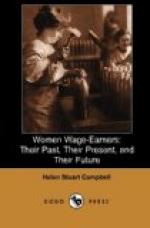As in every other trade, processes have divided and subdivided. Sewing-machines did away with the tedious binding by hand, which had its compensations, however, in the fact that it was done at home. There is only incidental record of the numbers employed in this industry till the later census returns; but the percentage outside of Massachusetts remained a very small one, as even in Maine the total number given in the Report of the Bureau of Labor for 1887 is but 533, an almost inappreciable per cent of the population. The returns of the census of 1880 give the total number of women in this employment as 21,000, the proportion still remaining largest for New England.
Straw-braiding was another of the early trades, and the first straw bonnet braided in the United States was made by Miss Betsey Metcalf, of Providence, R.I., in 1789. For many years straw-plaiting was done at home; but the quality of our material was always inferior to that grown abroad, our climate making it much more brittle and difficult to handle. The wage at first was from two to three dollars a week; but as factories were established where imported braid was made up, the sum sometimes reached five dollars. The census of 1860 gave the total number of women employed as 1,430. According to the census of 1870, nine States had taken up this industry, Massachusetts employing the largest number, and Vermont the least, the total number being 12,594; while in 1880 the number had risen to 19,998.
Up to the time of the Civil War, aside from factory employments, the trades open to women were limited, and the majority of their occupations were still carried on at home, or with but few in numbers, as in dressmaking-establishments, millinery, and the like. With the new conditions brought about at this time, and the vast number of women thrown upon their own resources, came the flocking into trades for which there had been no training, and which had been considered as the exclusive property of men. A surplus of untrained workers at once appeared, and this and general financial depression brought the wage to its lowest terms; but when this had in part ended, the trades still remained open. At the close of the war some hundred were regarded as practicable. Ten years later the number had more than doubled, and to-day we find over four hundred occupations; while, as new inventions arise, the number of possibilities in this direction steadily increases. The many considerations involved in these facts will be met later on. General conditions of trades as a whole are given in the census returns, though even there hardly more than approximately, little work of much real value being accomplished till the formation of the labor bureaus, with which we are soon to deal. Every allowance, however, is to be made for the Census Bureau, which found itself almost incapable of overcoming many of the lions in the way. The tone of the remarks on this point in that for 1860 is almost plaintive, nor is it less so in the next; but methods have clarified, and the work is far more authoritative than for long seemed possible.




